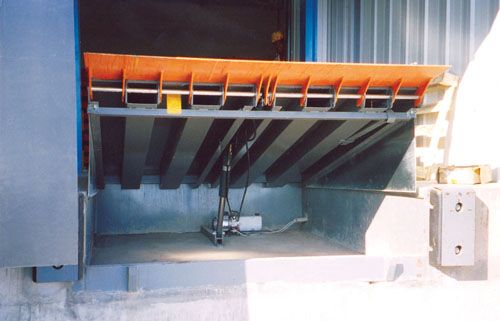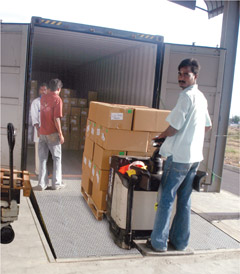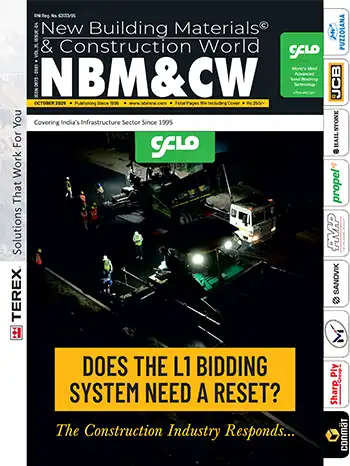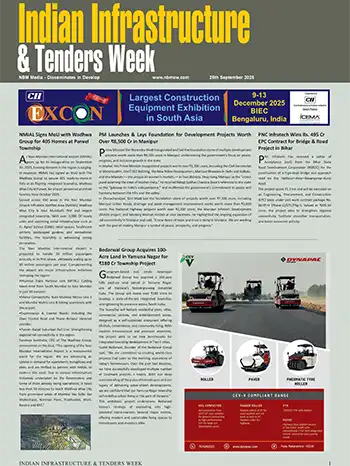
The dock levelers are steel platforms connecting the dock (to which they are hinged) to the truck bed of the vehicle, allowing the fork lift trucks to load the goods by getting on them.
During all the loading operations, the dock leveler is only an inert bridge which follows the lifting and lowering of the truck-bed of the vehicle on its suspensions, under the mass of the load and of the fork lift truck.
EN 1398
The dock levelers must conform to several European Norms. For some of these, like the 'Low tension directive 73/23/CEE and following updating," the buyer must only ask and obtain the relevant certifications as power of discretional does not enter into the fields of designing and buying. A concern may also ask for the photocopies of the tests made as some manufacturers certify the conformity without making any control with the specialized laboratories, and also if this has a penal character, it is very difficult that it comes alight.Instead it is necessary to pay attention to safety rules, for the dock levelers, that are under the 'machine Directory 89/392 CEE and further updating," in conformity to which the dock leveler is manufactured.
Within this Directive, in August 1997 for the dock levelers it has been approved under the European Norm EN 1398(C type norm, specific for product), treated and commented in the specific publication concerning the European Norms.

- Carrying capacity: the Norm defines that the nominal carrying capacity is considered as concentrated on only one axel of the fork lift truck, and discharged on two marks of 15x15 cm at 1 m of distance.
- Pay attention to the overload for "rolling": The carrying capacity of a dock leveler is to be reduced if the use of forklift trucks with smaller wheel marks than 15x15 cm is foreseen.
- Width of the dock leveler: the more similar to the width of the truck-beds, and with at least 35 cm between the external wheel of the forklift truck and the rim of the dock leveler. This Prescription brings to choose almost always dock levelers of 220cm width, with side flaps on the lip.
- Maximum working slope: up to maximum of an 8-10%. Do not confuse it with the maximum safety slope of the 12.5% (7degree) stated by the EN 1398. The working slope must be in line with the one that the fork lift truck can overtake. For example, many electric transpallets do not overtake more than 4% of slope at full load.
- Walking surface of the dock leveler: It must be anti-slippery and it must be easy to clean without retention of liquids. Almond sheets are fine, Striped sheets are forbidden.
- Blocking in rest position: the dock leveler inside the dock must be designed in a way that in rest position, it is at the same level with the pavement and it must be automatically supported in a way to allow crossing without risks also at full load.
- Foot guards and fingers distance: side foot guards are necessary in order to cover the gaps between dock and lifted dock leveler. The lip in rest position must have at least 25 mm of distance horizontally or vertically from possible frames, expect in correspondence of the two lip bearers.
- Side step evidence: the possible side step of the dock leveler and the one of the pit must be highlighted with yellow-black strips (5cm of height is sufficient)
- Usage instructions and/or ideogram indications: the commands must have brief instructions, better if with ideograms.
- Maintenance crutch: the dock levelers must be provided with a safety crutch with a positive clamping, in order to maintain them securely opened in case of maintenance.
- Emergency switch: the command board must be provided with an emergency switch, whose function can be taken by the door block switch as long as it is of red color on yellow background. The main power supply must be lockable in the OFF position for maintenance.
- Prevention of non supported operative position: the dock levelers of a mechanical type, example given by the counterbalanced dock levelers, must be designed in a way that they cannot remain in a horizontal unsupported position.
- Automatic safety stop: the unsupported dock levelers must have an automatic safety system which blocks the second movement in case it becomes dangerous and uncontrolled (for example in case of an accidental departure of the vehicle). This can be achieved , for example by an automatic valve directly inserted into the lift cylinder. The safety block must work only with a load superior to 10% of the maximum capacity. In case of a dock leveler with reduced height due to reduced space, if the cylinder has to be sensibly inclined, the 105 value may be brought to 25%. The value has to be specified by the manufacturer.
If the vehicle is interlocked with the dock leveler during the load, for example with a hook, the Automatic safety stop is not necessary. - Hydraulic and pneumatic: the circuit must be protected by a maximum pressure valve, adjusted to a maximum of the 115% of the working pressure. The hydraulic cylinders must resist to at least twice the working pressure without permanent deformations. The pneumatic ones at least three times. The pipes must resist at least three times the maximum working pressure and must be installed in a way to operate without bents and frictions. The parts subject to the pressure generated by the safety stop, must resist to this pressure. If the system is not self-venting, there must be a venting system.
- Prevention from non intentional movements: the dock levelers must be designed in a way to prevent non intentional movements during the loading movements during loadings. The manual dock levelers must be designed so as they cannot leave their position on the vehicle during the load. For example, by using bolts, bars or teeth which engage the rim of the dock.
- Information for use: the dock levelers must be supplied with the compulsory marking and with written instructions for use, including installation, electrical scheme, operations, maintenance and inspections, all in the official language of the country of installation. Marking must include: manufacturer or supplier, country of the manufacturer or supplier, type, production number, year of production, nominal load; and for the dock levelers with an outside power supply details of the power required (for the electric part: voltage, frequency, force)















